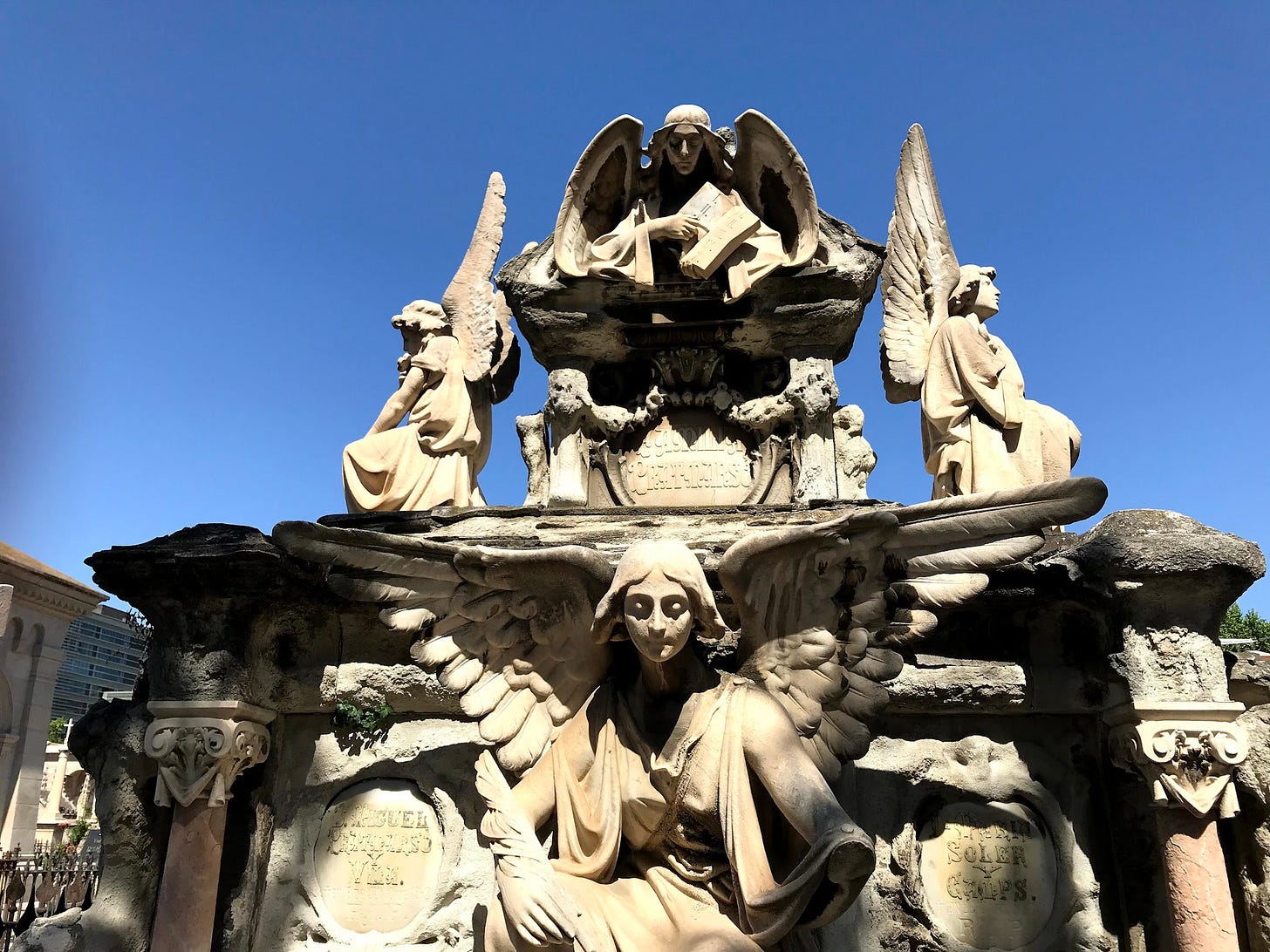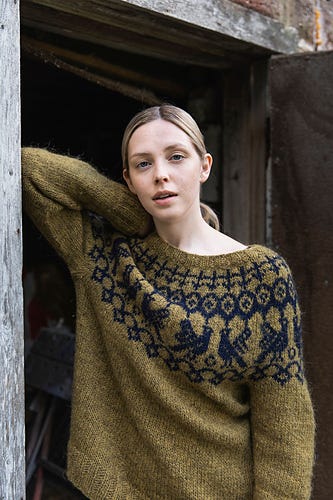This week, as I read through Jenna Kostet's Knitted Kalevala, I started thinking about the delicate balance between preserving the past, tradition, and embracing the future in knitting, innovating.
Knitting is a testament to our ingenuity and creativity, demonstrating the profound beauty that can be woven into the everyday threads of life. It offers not just warmth but also a connection to history, a portal to diverse cultures, and a canvas for innovation. As we knit our stitches, we're not just creating garments but also stories, traditions, with a sense of authenticity that transcends time and trends.
Knitting, with its rhythmic dance of needles and yarn, is a tradition passed down through generations.
Knitted colorwork motifs are narratives that transmit stories of cultures and communities. They are cultural artifacts, intricate and delicate, whispering stories that have been handed down through time. They have captured in their loops the imaginary universe and inner worlds of folks like us, from distant times, weaving together stories of our ancestors, of long gone folk we are distantly related to.
Yet, the world moves on and so does knitting. Trends emerge and fade, new patterns, techniques, and materials emerge, breathing fresh life into this age-old craft. The knitting community is a dynamic one, eagerly embracing and shaping trends that push the boundaries of the craft. And it's exciting and inspiring to watch.
So this week I talk about Jenna Kostet's book and what I learned on the history of knitting from Richard Rutt's, A history of hand-knitting, published in 1987.
Book of the week
Knitted Kalevala by Jenna Koste
Knitted Kalevala is an exploration of the intersection of knitting and folk poetry. Kostet, who formally studied ethnology and folklore, interprets the poems, the Kavelava, draws knitted motifs from them, discussed the meaning and use of these motifs and applies them to 18 knitted garments and accessories. It's so well written, so beautiful, so creative!
According to the author herself, Kalevala, Finland's national epic, is a collection of poems compiled by Elias Lönnrot (1802–1884), a Finnish scholar. Lönnrot travelled through Central and Eastern Finland, collecting poems from Häme to North Karelia, extending his travels to Estonia, the Kola Peninsula, and Karelia, amassing a wealth of material. Lönnrot's work in compiling Kalevala involved editing and modifying the collected material, as well as crafting new verses to create a cohesive collection.
In the first canto of the Kalevala, Ilmatar, a goddess of the air, descends into the sea and is impregnated by the wind and the water. A duck then builds a nest on her knee and lays eggs that later fall and shatter. The eggshells take the form of the moon, the sun, the sky, the earth, and the clouds.
Then the daughter of the Ether,
Now the hapless water-mother,
Raised her shoulders out of water,
Raised her knees above the ocean,
That the duck might build her dwelling,
Build her nesting-place in safety.
Thereupon the duck in beauty,
Flying slowly, looking round her,
Spies the shoulders of the maiden,
Sees the knees of Ether's daughter,
Now the hapless water-mother,
Thinks them to be grassy hillocks,
On the blue back of the ocean.
Thence she flies and hovers slowly,
Lightly on the knee she settles,
Finds a nesting-place befitting,
Where to lay her eggs in safety.
Here she builds her humble dwelling,
Lays her eggs within, at pleasure,
Six, the golden eggs she lays there,
Then a seventh, an egg of iron;
I love the idea of this book and how Kostet enables us to knit and wear poetry from a time long, long ago. It inspires me to look into my own culture's folklore and see how I may interpret these legends and motifs into my own craft.
Short history of knitting before 1500
Curious to learn more about the history of knitting, I started reading Richard Rutt's, A history of hand-knitting.
This is what I learned so far.
The history of knitting is quite the adventure, filled with intriguing twists and turns. One of the mysteries surrounding knitting is its origin. It's tempting to think that it all began at a particular time and place, but the truth is, that assumption doesn't quite hold up. The earliest evidence of knitting, like those 13th-century Spanish cushions and Egyptian fragments, doesn't give us a clear starting point.
Some intriguing theories suggest that crochet, Tunisian crochet, sprang, or netting might have paved the way for knitting. These crafts share certain similarities, like the use of hooks and working with yarn in somewhat similar ways, but their end products are fundamentally different.
Now, here's where it gets fascinating. Nalbinding, an ancient technique, might be the missing link in knitting's history. Nalbinding predates what we know about knitting and was used for making footwear in certain regions.
It's possible that knitting picked up a few tricks from nalbinding. Imagine someone in ancient times, experimenting with yarn and hooked rods. They figure out that new loops can be created by pulling them through the previous ones. Eventually, they discover that plain knitting needles work even better.
Knitting wasn't a one-size-fits-all craft, though. Different cultures, such as the Taulipang Indians and the Warrau people, had their unique knitting methods. They used separate rods or skewers for different parts of the fabric to create headbands and belts. The fascinating part is that their knitting style had nothing to do with the knitting we're familiar with from Europe.
Fast-forward to a place known as Dura-Europos, a bustling trade hub between the East and the West, in present-day Syria. In the early 20th century, three pieces of knitted fabric were discovered there, among the oldest examples we have. These fragments feature crossed loops and incorporate purl and plain stitches. The larger piece even boasts a pattern that somewhat resembles pomegranates.
Louisa Bellinger initially thought these fragments were created using flat knitting, but as it turns out, they were crafted through a technique known as “nalbinding.” It's like a well-kept knitting secret. Her instructions were a bit complex to follow. These fragments are invaluable because they offer insights into the ancient roots of knitting.
Oh, and speaking of socks, we need to talk about Romano-Egyptian socks. They're not your everyday socks; they rise up to the ankle and have a separate section for the big toe, likely designed for sandals. You can find them in various museums worldwide, even though some people refer to them as “Coptic socks.” But don't let the name mislead you; they have a rich history tied to Ancient Egypt, making them a captivating part of knitting's past.
Knitting is an extraordinary journey filled with intriguing surprises. It's not just one story; it's the captivating collection of remarkable tales from around the globe.
What am I making
I finished the second part of the back of my colorwork vest that I mentioned here, and I now need to pick up and knit the neckband and armholes.
I also cast on a round yoke sweater in Vovo by Retrosaria Rosa Pomar. I love Rosa Pomar's work and her yarn. I wrote about her book and her work here, but it's the first yarn made by them that I use. And having used it, I want to try more of it. But I still have a basket full of yarn to use before I can acquire anything new for my yarn pantry (insert, soft, poetic, silent cry).
The pattern I am using is DKR Everyday sweater by Andrea Mowry. Two things she does differently than other round yoke sweaters I knit: one, she tells you to cast on what seems like an extreme number of stitches for the collar (but it all works beautifully). Then the way she divides the yoke stitches and the number of stitches you pick up for the underarm seemed strange to me, yet it also works great.
May your days be filled with mindful moments. Until next time, be present.
Sky











Such a fascinating read, thank you Sky. The inspiration designers take from history, folklore and literature is amazing. Their interpretation of these sources in the knitted design is magical indeed.